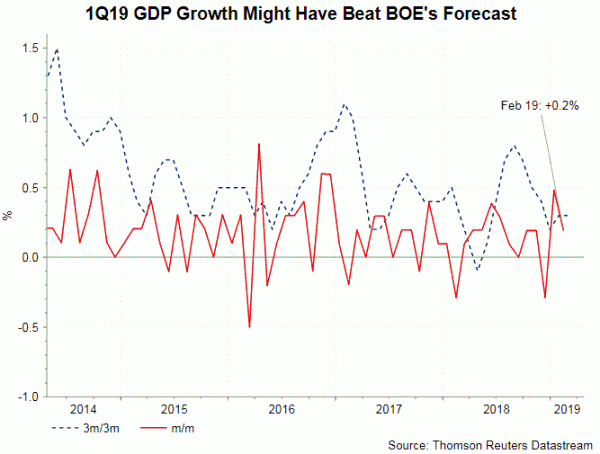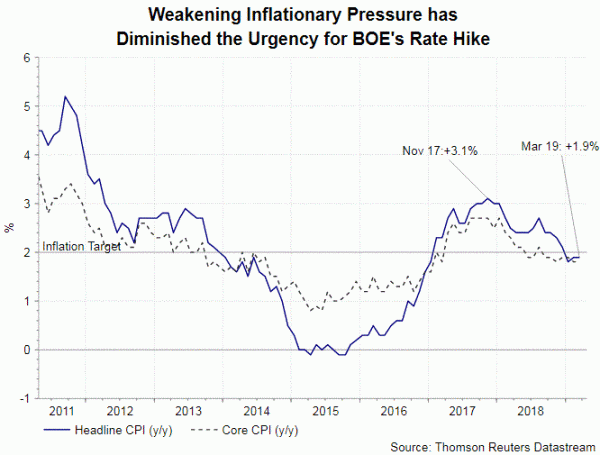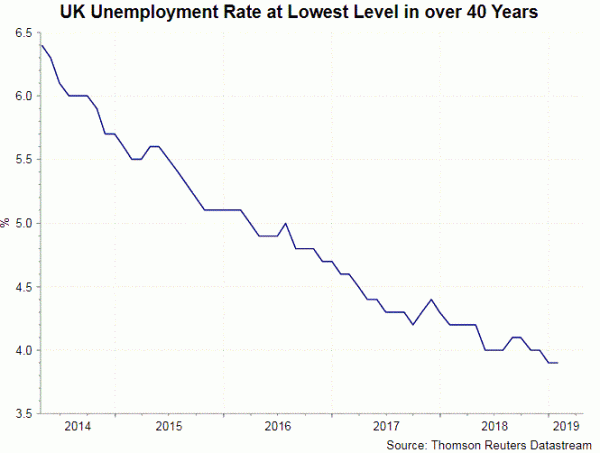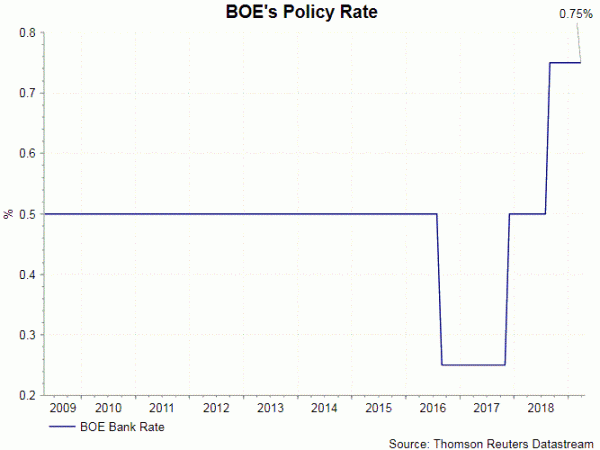Some positive notes are seen in the first quarter, both domestically and globally. Yet, these are neither sufficient not strong enough to alter BOE’s stance in May, the first monetary policy meeting since Brexit was offered an extension until October 31. The central bank is certain to leave its Bank rate at 0.75% and the asset purchase program at 435B pound. We expect the decision would be unanimous.
Strong GDP Growth Distorted by Front-Loaded Activities
GDP growth for 1Q19 surprised to the upside. GDP rose +0.2% m/m in February, down from January’s +0.5% but beat expectation of 0.1%. Index of services rose +0.1% m/m, while index of production rose +0.6% m/m. Rolling three-month growth rate (Dec to Feb) was unchanged at +0.3%. Stronger-than-expected February data has raised the likelihood that first quarter growth could have surpassed BOE’s projection of +0.3%. Note, however, that the figure should have been boosted by manufacturers “changing the timing of their activities”, i.e.: stockpiling, ahead of Brexit. As such, the strength in the first quarter might be offset by second and third quarters.
Inflation Stays within Target
Inflation continues to hover within BOE’s target range, giving the central bank more room to stand on the sideline. Headline CPI steadied at +1.9% y/y in March. Yet, the market had anticipated a pickup to +2%. Core CPI also stayed at +1.8%, also missing expectations of +1.9%. The job market is resilient. The number of payrolls increased +179K in the three months to February. Although it has pulled back from the 222K addition in the January period and slightly missed market forecast of +180K, the unemployment rate remained at record low of 3.9%. Meanwhile, average weekly earnings growth was firm at +3.5% y/y during the period.
Brexit Uncertainty Extended
Earlier this month, European Parliament approved that Brexit would be extended further to October 31. It is possible for the UK to leave earlier should the UK Parliament approve a Withdrawal Agreement (the deal). A review of the situation would take place in June so as to check if the UK has held its part of EU parliamentary election properly. It would the first MPC meeting that the members would assess the impacts on the economic outlook of such change.
Chancellor of the Exchequer Philip Hammond noted last Friday he was optimistic that a Withdrawal Agreement would be reached eventually through cross-party talks. Yet, he cautioned about the negative impact a of no-deal Brexit. As he suggested, no-deal Brexit would “inflict serious short term turbulence on our economy and long term damage, reducing Britain’s growth level and reducing the living standards of the British people”. In our opinion, while this arrangement offers temporary relief to the market as the UK avoids leaving the EU without a deal this month, the risk of no-deal Brexit is still not eliminated. As such, extending Brexit is prolonging uncertainty. This is something that BOE should take into account.
Maintaining Gradual Rate Hike Bias
On the forward guidance, we expect BOE to reiterate the stance that the policy rate would increase “at a gradual pace, and to a limited extent” over the next couple of years. and that any decision would “not be automatic and could be in either direction”. The central bank is certain to leave its Bank rate at 0.75% and the asset purchase program at 435B pound. We expect the decision would be unanimous, although some hawks, such as Michael Saunders might give some hawkish comments at the meeting.

















